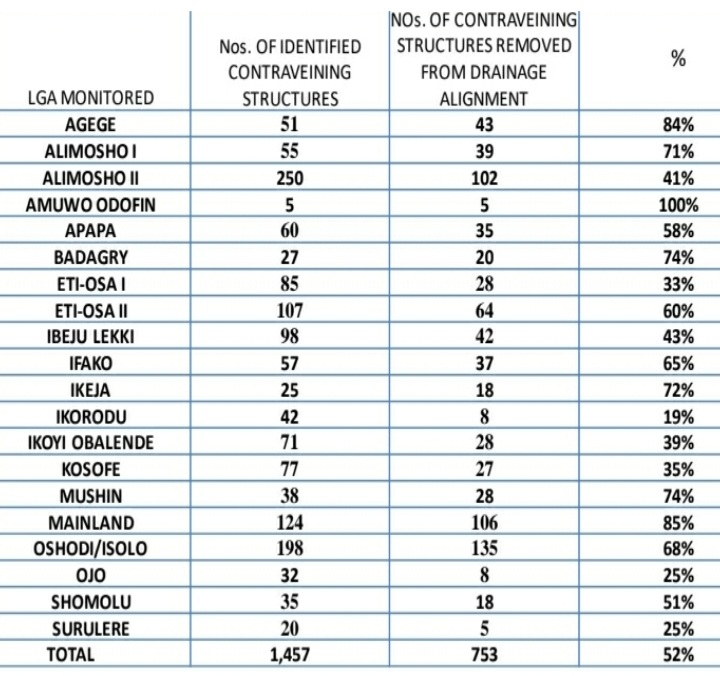Flooding: How prepared is Lagos for 2024 rain season

By Femi Akinola
Events of flooding in Lagos State are no longer new because flood has become a reoccuring situations in the state. It usually happened every year particularly during the rain season, from June to October, with severe implications.
The affected flood prone areas in Lagos are but not limited to Aboru community in Alimosho Local Government Area, Meiran, Kara, Isheri-Olowora, Agiliti around Mile 12 along Lagos-Ikorodu expressway, Majidun, Owode Elede, Agboyi community, Itowolo area in Ikorodu part of the state, Ebute-Metta, Ajegunle, Lekki-Ajah axis among others.
One of the major flood prone areas in the Lekki axis is a community popularly known and called – Agungi. In this community, there is no proper drainage channels. Whenever it rain, the central road and some streets within Agungi are known for flash flooding which often come along with soil erosion and degradation of the environment. Such happened in many communities in Lagos metropolis.
Investigations conducted into prepartion of Lagos State for the 2024 rain season showed there re other factors responsible for the causes of flood in Lagos.

This include the topography of the area, Land Use, and Land Cover modifications, and influence of canals, lagoons, and beaches. Other factors observed include urbanisation and population growth, poor urban planning, ineffective waste management and many resident’s delibrate dumping of waste in the gutters and drainges, whenever it rains.
Over the past two decades, the causes of flooding in Lagos, the commercial nerve of the country, have received significant mentioning in the media, both in the print and electronic.
Debate arising from the reports published or aired in the past two decades indicated that Lagos floods are mainly the consequence of climate change induced short duration-high intensity or long-duration-low intensity rainfall, according to Houston et al., 2021.
NatureNews investigations over yearly flash flood in Lagos State showed that the state is one of the few locations in Nigeria with more frequent flash flood events. In the past, a number of destructive floods have taken place in Lagos.
The investigations revealed that more severe flooding has taken place in the state in the past 10 years. The problem with getting adequate and reliable data on the impact of flash flood on the people of Lagos is that it is challenging to get accurate data on effects of flood in the citystate majorly due to lack of data collection.
Data relating to flood duration, destruction and impacts in terms of the number of people affected, displaced or properties destroyed, and the economic losses were not available as of the time of writing this report.
It is on the basis of this non-availability of dependable data and information including effectiveness of flood management in the state is being queried in some quarters.
In many cases, for example, different types of flood damage were aggregated. Indeed, this situation was found to be adversely affects accurate flood damage estimation since a critical understanding of Lagos flood risk in the context of flood damage typology is difficult.
In order to qualitatively identify flood risk level and damage caused by flood in the state, an approach used in the 2005 World Bank Hotspot project is an indicator.
In the project report, records of flood events and affected areas coupled with the population density of the city centre as mapped in the GIS indicated that Ajeromi- Ifelodun Local Government Area and Mushin areas areat a higher risk of flooding than other parts of the state.
This information, regardless of its simplicity, offers a potentially valuable insight into flooding patterns in Lagos. According to previous studies on flood in the state, more severe flooding hs been recorded in select areas of Lagos including Apapa, Lagos Island, Ikeja, Mushin, Surulere and partf of Ikorodu.
On the other side, checks on activities of the state government over deflooding Lagos showed the vision statement of Lagos State Ministry of the Environment to be a flood free, hygienic and aesthetically beautiful Lagos with sustainable development and mangement of its water resources. Has the state government live up to people’s expectation as regard ensuring a flood free Lagos?
While briefing the press about the activities of his ministry during 2024 Ministerial Press Briefing at the Alausa Seretariat, Ikeja, the State Commissioner for the Environment and Water Resources, Mr. Tokunbo Wahab, said the ministry, in 2023 alone, through the Emergency Flood Abatement Gang (EFAG) department, 34 numbers of primary channels, totalling approximately 115 kilometres length were approved and executed under the maintenance dredging of Primary Channels Programme to curb flash flood in the state.
He said, ”Most of these primary channels span all the 20 local government areas and effectively drain several catchment areas simultaneously while 144 numbers of secondary collectors covering 125.7 km spread throughout the 20 local government areas of the state were cleaned in preparation for a flood free Lagos.”
For this year deflooding activities of the ministry, the commissioner disclosed that for the Primary Channels Dredging which is about to commence, 39 primary channels with a total length of approximately 117.76km length has been aprovedfor execution while about 281 collectors drains totalling approximately 242.km in length, spread across the 20 local government areas in the state has been approved for cleaning.
